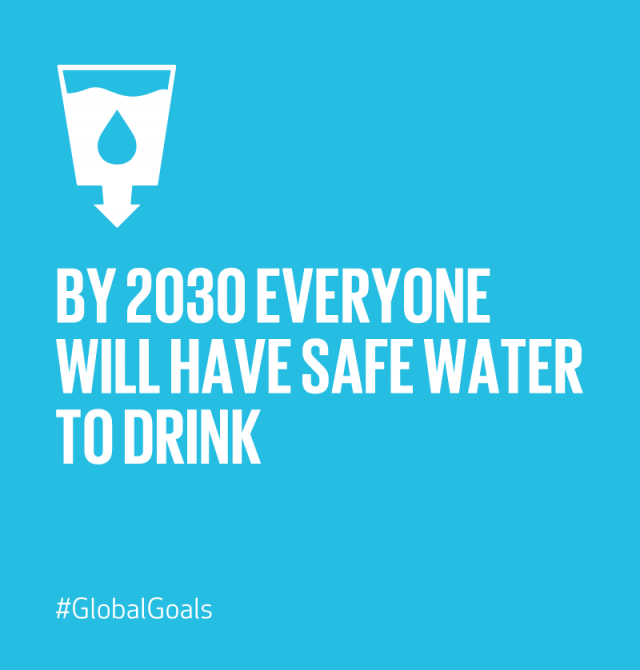"Leaving no one behind" — the animating theme of the UN Sustainable Development Goals (SDGs) — is just as relevant to the U.S. as it is to low- and middle-income countries. This is particularly apparent in Flint, Michigan, where an ongoing water contamination crisis has taken center stage in a national conversation about inequality in the United States.
The news first broke in 2014 that Flint city officials had decided to source water from the heavily polluted Flint River, leading to a dangerous contamination of the water supply with lead. But Reuters’ journalists Michael Pell and Joshua Schneyer later found that Flint is just the tip of the iceberg: while lead poisoning is falling on average nationwide, 40-50 percent of children in some U.S. neighborhoods still have dangerously high levels of lead in their blood. The human costs of these local “hotspots” are grim, with studies showing that lead exposure can permanently and significantly impair cognitive function.
The story of how these deadly hotspots went undetected showcases why we need more granular data to effectively respond to inequality in the U.S. and beyond. To help solve the problem, AidData is working to develop better data and tools that will enable policymakers and practitioners to identify vulnerable populations, target resources to these groups, and monitor progress and differential impacts from policies and programs.

How did these local hotspots go unnoticed for so long?
Previously, most data on lead poisoning levels were available at only the county and city levels in the U.S. The use of aggregate county- and city-level data made it difficult for state and federal authorities to "see" smaller hotspots of lead exposure within those same counties and cities. Pell and Schneyer, the Reuters’ journalists, filed an open records request to obtain disaggregated data at both the zip code and census tract levels for all fifty U.S. states. Census tracts are county subdivisions that usually consist of about 4000 residents, while zip codes contain around 7500 residents. There are more than 73,000 census tracts and 42,000 zip codes in the U.S., but only about 3,100 counties and county equivalents (including cities).
The prognosis for U.S. communities depends on your vantage point
In a 2010 report, the Agency for Toxic Substances and Disease Registry (ATSDR), a branch of the Center for Disease Control, optimistically declared that children living in East Chicago in Lake County, Indiana were “no longer exposed to lead from any source” and the levels of lead in their blood were “consistent with the national average” — despite their proximity to a former lead smelting plant and Superfund site. Yet in 2016, the mayor of East Chicago cited evidence of high levels of lead contamination in the soil as his rationale for razing the West Calumet housing complex and relocating its 1100 poor and predominantly African-American residents (including 670 children).
The underlying reason for the discrepancy was simple: the data that the ATSDR used to arrive at its conclusions were not sufficiently granular. It turns out that although East Chicago had an average rate of lead exposure in line with the rest of the country, the West Calumet housing complex within census tract 303 did not. What ATSDR officials missed using county- and city-level aggregates, Pell and Schneyer caught using more granular data at the census tract level: a pocket of alarming levels of child lead exposure hidden within a much larger subnational locality.
Census tract 303 is home to just 2,500 residents out of the half a million plus living in Lake County’s 104 census tracts. Pell and Schneyer’s investigation shined a bright spotlight on the 22 percent of children in census tract 303 (including West Calumet) with elevated levels of lead in their blood. To put this figure into context, children in this census tract are two times more likely than their counterparts in other census tracts to have elevated levels of lead in their blood.
Ensuring no one is left behind requires both high-resolution data and incentives for use
The case of census tract 303 in Indiana is a cautionary tale for leaders in the U.S. and around the world. Putting our trust in top-line trends can mask pockets of inequality within countries that will persist if resources are not being carefully targeted to these areas of greatest need. The recognition that inequality is not only a problem between countries, but also within, is central to Agenda 2030 and the SDGs. If global policymakers and practitioners want to translate the rhetoric of “no one left behind” into practice, they must prioritize resources and attention to benefit at-risk communities.
A forthcoming AidData report, Avoiding Data Graveyards, provides evidence that the demand in many countries for data on development inputs and outcomes disaggregated by geography and demography far outstrips the supply of this information. In response to this challenge, AidData is developing new methods and tools that policymakers and practitioners can use to more precisely track where development projects are geographically sited (e.g., village, district, and province) and who stands to benefit the most and least from such investments (e.g., persons with disabilities and women and children).
However, high-resolution data and next-generation methods and tools will only ensure that sustainable development is inclusive for all if those who are entrusted with allocating resources and monitoring progress are actually willing and able to put this information to use. Since policymakers and practitioners are guided by their own internal cost-benefit calculations, AidData is working to co-create data and tools with forward-leaning organizations that are not satisfied with the status quo and want to more efficiently target their resources based upon need and opportunity.
We’re also using our Listening to Leaders survey to pinpoint the common pain points and felt needs of public, private, and civil society leaders who want to use development data in their work and increase the utility of the information available to them. We will release a report analyzing the survey results later this year to share the lessons learned — so stay tuned!


